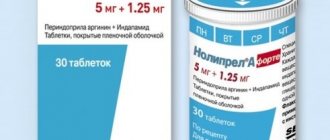About the drug Reduxin
Lactic acidosis
Lactic acidosis is a rare but serious (high mortality unless promptly treated) complication that may occur due to accumulation of metformin. Cases of lactic acidosis when taking metformin occurred mainly in diabetic patients with severe renal failure.
Other associated risk factors should be taken into account, such as decompensated diabetes mellitus, ketosis, prolonged fasting, alcoholism, liver failure and any condition associated with severe hypoxia. This may help reduce the incidence of lactic acidosis.
The risk of developing lactic acidosis should be taken into account when nonspecific signs appear, such as muscle cramps accompanied by dyspeptic symptoms, abdominal pain and severe asthenia. Lactic acidosis is characterized by acidotic shortness of breath, abdominal pain and hypothermia followed by coma. Diagnostic laboratory parameters are a decrease in blood pH (less than 7.25), lactate content in the blood plasma over 5 mmol/l, increased anion gap and lactate/pyruvate ratio. If metabolic acidosis is suspected, stop taking the drug and consult a doctor immediately.
Surgical operations
The use of the drug Reduxin® Forte should be discontinued 48 hours before planned surgical operations and can be continued no earlier than 48 hours after, provided that during the examination, renal function was found to be normal.
Kidney function
Since metformin is excreted by the kidneys, before starting to take the drug Reduxin® Forte and regularly thereafter, it is necessary to determine CC: at least once a year in patients with normal renal function, and 2-4 times a year in elderly patients, as well as in patients with CC at the lower limit of normal.
Particular caution should be exercised in case of possible impairment of renal function in elderly patients, with simultaneous use of antihypertensive drugs, diuretics or non-steroidal anti-inflammatory drugs.
Patients are advised to continue to follow a diet with even carbohydrate intake throughout the day. Overweight patients are recommended to continue to follow a hypocaloric diet (but not less than 1000 kcal/day).
It is recommended that routine laboratory tests be performed regularly to monitor diabetes mellitus.
It is recommended to exercise caution when using Reduxin® Forte in combination with insulin or other hypoglycemic agents (including sulfonylurea derivatives, repaglinide).
Treatment with Reduxin® Forte should be carried out as part of complex therapy for weight loss under the supervision of a physician with practical experience in the treatment of obesity. Complex therapy includes both changing diet and lifestyle, as well as increasing physical activity. An important component of therapy is to create the prerequisites for persistent changes in eating behavior and lifestyle, which are necessary to maintain the achieved weight loss even after drug therapy is discontinued. As part of therapy with Reduxin® Forte, patients need to change their lifestyle and habits in such a way as to ensure that the achieved weight loss is maintained after completion of treatment. Patients should be clear that failure to comply with these requirements will lead to repeated weight gain and repeated visits to their doctor.
In patients taking the drug Reduxin® Forte, it is necessary to measure blood pressure and heart rate. During the first 3 months of treatment, these parameters should be monitored every 2 weeks and then monthly. If during two consecutive visits an increase in resting heart rate ≥10 beats per minute or systolic/diastolic pressure ≥10 mmHg is detected. Art., it is necessary to stop treatment. In patients with arterial hypertension whose blood pressure is above 145/90 mm Hg during antihypertensive therapy. Art., this control should be carried out especially carefully and, if necessary, at shorter intervals. In patients whose blood pressure exceeded 145/90 mmHg twice during repeated measurements. Art., treatment with Reduxin® Forte should be suspended (see section “Side effects”, subsections “Heart disorders”, “Vascular disorders”).
In patients with sleep apnea, blood pressure must be monitored especially carefully.
The simultaneous administration of drugs that increase the QT interval requires special attention. These drugs include H1-histamine receptor blockers (astemizole, terfenadine); antiarrhythmic drugs that increase the QT interval (amiodarone, quinidine, flecainide, mexiletine, propafenone, sotalol); gastrointestinal motility stimulator cisapride; pimozide, sertindole and tricyclic antidepressants. This also applies to conditions that can lead to an increase in the QT interval, such as hypokalemia and hypomagnesemia (see section “Interaction with other drugs”).
The interval between taking MAO inhibitors (including furazolidone, procarbazine, selegiline) and Reduxin® Forte should be at least 2 weeks.
Although a connection has not been established between taking sibutramine and the development of primary pulmonary hypertension, however, given the well-known risk of drugs in this group, with regular medical monitoring it is necessary to pay special attention to symptoms such as progressive dyspnea (breathing difficulty), chest pain and swelling in the legs .
If you miss a dose of Reduxin® Forte, you should not take a double dose of the drug at the next dose; it is recommended to continue taking the drug according to the prescribed regimen.
When taking sibutramine and other serotonin reuptake inhibitors together, there is an increased risk of bleeding. In patients predisposed to bleeding or taking drugs that affect hemostasis or platelet function, sibutramine should be used with caution.
Although there is no clinical evidence of addiction to sibutramine, the patient's history of drug dependence should be assessed and attention should be paid to possible signs of drug abuse.
Reduxin caps 10 mg x60
Trade name: Reduksin International name: Sibutramine+[Microcrystalline cellulose]& (Sibutramine+Cellulose microcrystallic) Pharmacological group: obesity treatment Pharmacological group according to ATC: A08AA. Drugs for the treatment of obesity with central action Pharmacological action: monoamine reuptake inhibitor, treatment for obesity Pharmacodynamics: Combined drug for the treatment of obesity, the effect of which is determined by its constituent components. Sibutramine is a prodrug and exerts its effect in vivo through metabolites (primary and secondary amines) that inhibit the reuptake of monoamines (mainly serotonin and norepinephrine). An increase in the content of neurotransmitters in synapses increases the activity of central serotonin 5-HT receptors and adrenergic receptors, which increases the feeling of satiety and reduces the need for food, as well as an increase in thermal production. By indirectly activating beta 3-adrenergic receptors, sibutramine acts on brown adipose tissue. A decrease in body weight is accompanied by an increase in the concentration of HDL in the blood serum and a decrease in the amount of triglycerides, total cholesterol, LDL, and uric acid. Sibutramine and its metabolites do not affect the release of monoamines, do not inhibit MAO, and do not have an affinity for a large number of neurotransmitter receptors, including serotonin (5-HT1, 5-HT1A, 5-HT1B, 5-HT2A, 5-HT2C), adrenergic receptors (beta 1, beta 2, beta 3, alpha 1, alpha 2), dopamine (D1, D2), muscarinic, histamine (H1), benzodiazepine and NMDA receptors. Microcrystalline cellulose is an enterosorbent, has sorption properties and a nonspecific detoxification effect. Binds and removes from the body various microorganisms, their metabolic products, toxins of exogenous and endogenous nature, allergens, xenobiotics, as well as an excess of certain metabolic products and metabolites responsible for the development of endogenous toxicosis. Pharmacokinetics: Absorption, distribution, metabolism After taking the drug orally, sibutramine is quickly absorbed from the gastrointestinal tract, no less than 77%. It is subject to the effect of the first passage through the liver and is biotransformed with the participation of the CYP3A4 isoenzyme with the formation of two active metabolites (mono- and didesmethylsibutramine). After taking a single dose of 15 mg, the Cmax of monodesmethylsibutramine is 4 ng/ml (3.2-4.8 ng/ml), didesmethylsibutramine - 6.4 ng/ml (5.6-7.2 ng/ml). The Cmax of sibutramine is achieved after 1.2 hours, of active metabolites - after 3-4 hours. Taking along with food reduces the Cmax of metabolites by 30% and increases the time to reach it by 3 hours, without changing the AUC. Quickly distributed into tissue. The binding of sibutramine to plasma proteins is 97%, and mono- and didesmethylsibutramine is 94%. Css of active metabolites in the blood is achieved within 4 days after the start of treatment and is approximately 2 times higher than the plasma level after taking a single dose. Elimination T1/2 of sibutramine - 1.1 hours, monodesmethylsibutramine - 14 hours, didesmethylsibutramine - 16 hours. Active metabolites undergo hydroxylation and conjugation to form inactive metabolites, which are excreted primarily by the kidneys. Indications for use: To reduce body weight in the following conditions: alimentary obesity with a body mass index (BMI) of 30 kg/m2 or more, alimentary obesity with a BMI of 27 kg/m2 or more in combination with other risk factors caused by excess body weight ( diabetes mellitus type 2 /non-insulin dependent/ or dyslipoproteinemia). Contraindications: the presence of organic causes of obesity (for example, hypothyroidism), serious eating disorders (anorexia nervosa or bulimia nervosa), mental illness, Gilles de la Tourette syndrome (generalized tics), concomitant use of MAO inhibitors (for example, phentermine, fenfluramine, dexfenfluramine, ethylamphetamine, ephedrine) or their use within 2 weeks before prescribing Reduxin, the use of other drugs acting on the central nervous system (for example, antidepressants, antipsychotics), drugs prescribed for sleep disorders containing tryptophan, as well as other centrally acting drugs for weight loss body, coronary artery disease, decompensated chronic heart failure, congenital heart defects, occlusive diseases of peripheral arteries, tachycardia, arrhythmias, cerebrovascular diseases (stroke, transient cerebrovascular accident), uncontrolled arterial hypertension (BP above 145/90 mm Hg), thyrotoxicosis, severe liver dysfunction, severe kidney dysfunction, benign prostatic hyperplasia, pheochromocytoma, closed-angle glaucoma, established drug, drug or alcohol addiction, pregnancy, lactation (breastfeeding), children and adolescents under 18 years of age, elderly over 65 years of age, known hypersensitivity to sibutramine or other components of the drug. With caution: The drug should be prescribed with caution in the following conditions: a history of arrhythmias, chronic circulatory failure, coronary artery disease (including a history), cholelithiasis, arterial hypertension (controlled and in history), neurological disorders, including mental retardation development and convulsions (including a history), impaired liver and/or kidney function of mild to moderate severity, a history of motor and verbal tics. https://reduxin.ru/instruction/ Dosage regimen: Reduxin is prescribed orally 1 time/ The dose is set individually, depending on tolerability and clinical effectiveness. The recommended starting dose is 10 mg; in case of poor tolerance, a dose of 5 mg can be taken. Capsules should be taken in the morning, without chewing and with sufficient liquid. The drug can be taken on an empty stomach or combined with meals. If within 4 weeks from the start of treatment a reduction in body weight of 5% or more is not achieved, then the dose is increased to 15 mg. The duration of therapy with Reduxin should not exceed 3 months in patients who do not respond well to therapy (i.e. within 3 months of treatment it is not possible to reduce weight by 5% of initial body weight). Treatment should not be continued if, with further therapy (after achieving a reduction in body weight), the patient again gains 3 kg or more in body weight. The total duration of therapy should not exceed 2 years, since there are no data on efficacy and safety for a longer period of taking sibutramine. Therapy with Reduxin should be carried out by a doctor with practical experience in the treatment of obesity. Taking the drug should be combined with diet and exercise. Side effects: Side effects, depending on the effect on organs and organ systems, are presented in the following order (often - >10%, sometimes - 1-10%, rarely - from the central nervous system and peripheral nervous system: often - dry mouth, insomnia, sometimes - headache, dizziness, anxiety, paresthesia, as well as changes in taste, in isolated cases - back pain, depression, drowsiness, emotional lability, anxiety, irritability, nervousness, convulsions. In one patient with schizoaffective disorder, which is suspected existed before the start of treatment, after treatment acute psychosis developed. From the cardiovascular system: sometimes - tachycardia, palpitations, increased blood pressure, vasodilation. There is a moderate increase in blood pressure at rest by 1-3 mmHg and a moderate increase in pulse by 3-7 beats per minute. In some cases, more pronounced increases in blood pressure and heart rate cannot be excluded. Clinically significant changes in blood pressure and heart rate are recorded mainly at the beginning of treatment (in the first 4-8 weeks). From the digestive system: often - loss of appetite, constipation, sometimes - nausea, exacerbation of hemorrhoids. If you are prone to constipation in the first days, monitoring the evacuation function of the intestines is necessary. If constipation occurs, stop taking it and take a laxative. In isolated cases, abdominal pain, paradoxical increase in appetite, transient increase in the activity of liver enzymes. Dermatological reactions: sometimes - sweating, in isolated cases - itching, Henoch-Schönlein purpura (bleeding into the skin). From the body as a whole: in isolated cases the following undesirable clinically significant phenomena have been described: dysmenorrhea, edema, influenza-like syndrome, thirst, rhinitis, acute interstitial nephritis, bleeding, thrombocytopenia. Withdrawal reactions such as headache or increased appetite are rare. There is no evidence that withdrawal symptoms, withdrawal symptoms or mood disturbances occur after treatment. Most often, side effects occur at the beginning of treatment (in the first 4 weeks). Their severity and frequency weaken over time. Side effects are generally mild and reversible. Overdose: There are extremely limited data on overdose of sibutramine. Symptoms: increased severity of side effects. Specific signs of overdose are unknown. Treatment: taking activated charcoal, gastric lavage, symptomatic therapy, with increased blood pressure and tachycardia - prescribing beta-blockers. There is no specific antidote. It is necessary to carry out general measures: ensure free breathing, monitor the state of the cardiovascular system, and, if necessary, carry out supportive symptomatic therapy. The effectiveness of forced diuresis or hemodialysis has not been established. Interaction: Inhibitors of microsomal oxidation, incl. CYP3A4 inhibitors (including ketoconazole, erythromycin, cyclosporine) increase plasma concentrations of sibutramine metabolites with an increase in heart rate and a clinically insignificant increase in the QT interval. Rifampicin, macrolide antibiotics, phenytoin, carbamazepine, phenobarbital and dexamethasone can accelerate the metabolism of sibutramine. The simultaneous use of several drugs that increase the level of serotonin in the blood can lead to the development of a serious interaction. The so-called serotonin syndrome can develop in rare cases when Reduxin is used simultaneously with selective serotonin reuptake inhibitors (drugs for the treatment of depression), with certain drugs for the treatment of migraines (sumatriptan, dihydroergotamine), with potent analgesics (pentazocine, pethidine, fentanyl) or antitussives drugs (dextromethorphan). Sibutramine does not affect the effect of oral contraceptives. When sibutramine and ethanol were taken simultaneously, there was no increase in the negative effects of ethanol. However, alcohol consumption is absolutely not combined with the dietary measures recommended when taking sibutramine. Special instructions: Reduxin should be used only in cases where all non-drug measures for weight loss are ineffective - if the weight loss over 3 months is less than 5 kg. Treatment with Reduxin should be carried out as part of complex therapy for weight loss under the supervision of a physician with practical experience in the treatment of obesity. Complex therapy for obesity includes both changes in diet and lifestyle, as well as increased physical activity. An important component of therapy is the creation of prerequisites for permanent changes in eating habits and lifestyle, which are necessary to maintain the achieved weight loss even after drug therapy is discontinued. As part of therapy with Reduxin, patients need to change their lifestyle and habits in such a way as to ensure that the achieved weight loss is maintained after completion of treatment. Patients should be clear that failure to comply with these requirements will lead to repeated weight gain and repeated visits to their doctor. In patients taking Reduxin, it is necessary to measure blood pressure and heart rate. During the first 2 months of treatment, these parameters should be monitored every 2 weeks and then monthly. In patients with arterial hypertension (whose blood pressure levels are above 145/90 mmHg during antihypertensive therapy), this monitoring should be carried out especially carefully and, if necessary, at shorter intervals. In patients whose blood pressure exceeded 145/90 mmHg twice during repeated measurements. Art. treatment with Reduxin should be suspended. The simultaneous administration of drugs that increase the QT interval requires special attention. These drugs include histamine H1 receptor blockers (astemizole, terfenadine), antiarrhythmic drugs that increase the QT interval (amiodarone, quinidine, flecainide, mexiletine, propafenone, sotalol), gastrointestinal motility stimulants (cisapride, pimozide, sertindole and tricyclic antidepressants). Caution should be exercised when using the drug against conditions that are risk factors for increasing the QT interval (hypokalemia, hypomagnesemia). The interval between taking MAO inhibitors and Reduxin should be at least 2 weeks. The connection between taking Reduxin and the development of primary pulmonary hypertension has not been established, however, given the well-known risk of drugs in this group, with regular medical monitoring it is necessary to pay special attention to symptoms such as progressive dyspnea (breathing difficulty), chest pain and swelling in the legs. Effect on the ability to drive vehicles and operate machinery Taking the drug Reduxin may limit the patient’s ability to drive vehicles and operate machinery.
Manufacturer: Ozon LLC, Russia Registration certificate holder: Avista LLC, Russia Release forms: capsules 10 mg, 15 mg (polymer jars, cellular contour packaging) Composition: sibutramine hydrochloride monohydrate 10/15 mg, microcrystalline cellulose 158.5/153.5 mg Belonging to the lists : Potent Shelf life: 3 years Registration data: LS-002110 dated 04/23/2010 Registration certificate status: valid HS codes: 3004 90 190 9






